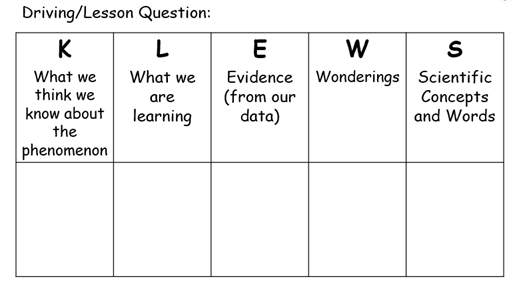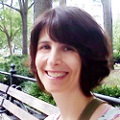Get a KLEW(S)! Collaboration is Key for Translating Contemporary Research into Teaching, Learning Science
Posted on 2019-05-28
I first encountered the KLEWS teaching strategy in an article in Science and Children (NSTA 2015), “KLEWS to Explanation-Building in Science.” I shared the article and modeled the strategy with teachers who wanted to support their K–5 students in the science practice of constructing explanations. I really liked the KLEWS chart. About a month ago, I had the opportunity to collaborate with other educators (read as: I needed help) while developing a first-grade lesson about sound. I discovered how KLEWS charts honor students’ ideas about phenomena, support students in developing explanations and models, and help teachers and students connect today with yesterday, and decide where to go next (coherence). Now I L-O-V-E the K-L-E-W-S chart!
The KLEWS chart is a revamped version of the KWL chart (What do we know? What do we wonder? What did we learn?) for science. Columns were added for evidence and science ideas and words (Hershberger and Zembal-Saul 2015).

But I’ll return to the KLEWS chart in a minute.
The Sound Lesson:
I wanted to create an opportunity for students to make sense of the DCI element PS3.A: Sound can make matter vibrate, and vibrating matter can make soundand use the element of the CCC Cause and Effect Events have causes that generate observable patterns as a lens to help students organize their thinking. The phenomenon I chose (and was really excited about) focused on Evelyn Glennie, a deaf percussionist who hears with her feet. In a clip from Sesame Street, Glennie removes her shoes as she prepares to audition for Oscar the Grouch’s band. She tells a confused Oscar that this helps her hear the music.
I wanted to ask the first-grade students to draw a model to explain how someone can hear with their feet (SEP element: Developing and Using Models Develop a model to represent relationships in the natural world) but I wasn’t sure they could. Maybe they could draw the model with some scaffolding, but I wondered how much would be needed.
I reached out to my friend Beth Pesnell for help. Beth is a former elementary school teacher and K–8 math and science curriculum specialist (she is currently pursuing a Ph.D.). She assured me first-grade students could draw a model. “Give them a blank piece of paper!” she said excitedly.
Beth also knew I wanted to give students the opportunity to revise models at different points in the multi-day lesson and asked if I had considered using a KLEWS chart. She listened to my ideas about the lesson and together we made the following plan (details are limited due to space constraints).
Kate and Beth’s Plan
- Post the KLEWS chart in the room.
- Read The Listening Walk to the class. (This book does not steal students’ “ahas” about how we hear or how sounds are made.) The book ends by asking, “How many different sounds can you hear right now? Close your book and count them!”
- Ask students, “What do you think we know about how we hear?” Record their responses under K.
- Introduce the phenomenon (Evelyn Glennie playing drums with Oscar the Grouch); ask students to share their thinking with a partner.
- Ask students to draw (individually) a model to explain how Evelyn Glennie hears with her feet.
- Tell students to put their models away (or collect them) (don’t ask them to share yet).
- Give students the opportunity to explore sound at different stations around the room.
- Say to students “You probably have some new ideas about sound and how we hear. What would you like to change or add to your model?” Give students time to revise their models.
- Ask students to join their predetermined groups and share what they changed or added to their model, and explain why.
- Ask students to share with the class what they heard other students say they added to their model and why. Record their responses in the L column. (I was intentional about where each response was recorded – keeping them next to/in line with related “things we think we know” in the K column.)
- Each time a response is recorded in the L column, ask students for evidence to support the learning. Record the evidence under E, keeping it next to/in line with to the L response it supports.
- In the S column, record the big science ideas students may have verbalized or described in their learning statements. Concepts are recorded in the S column throughout the lesson, when students connect the ideas with their learnings (L column).
- As new “wonderings” are expressed, record them in the W column. (Again, I was intentional where I recorded their questions in this column.)
- This learning experience and model will help inform the engineering design found in 1-PS4-4.
Wow! I was excited to teach the lesson, but also a bit nervous because I hadn’t used the KLEWS chart like this before. I was unfamiliar with the intentionality of where ideas are recorded in the columns, the fluidity between columns, and the navigation back and forth between the chart and student models as the lesson progressed. I wondered if I could find a video to help me visualize how to use the KLEWS chart (spoiler alert: I did).
I found a Teaching Channel blog post titled KLEWS: Supporting Claims, Evidence and Reasoning. The blog instructs educators on how to begin using the KLEWS chart in their classrooms by inviting us to watch third-grade teacher Maria Katsanos and her students using the KLEWS chart for the first time in the classroom. In a series of videos, we see Katsanos use the KLEWS chart to plan her lesson, support student sense-making, and reflect on how it required her to change the way she thought about teaching science. (Thanks to Katsanos for bravely trying something new with an audience for the benefit of other educators and their students.)
As I watched Katsanos and her students, I made notes on my lesson: What should I listen for in students’ conversations? What questions could I ask to get students thinking about their evidence? Which anticipated student “learnings” might lead to concepts/words to record in the S column? I suddenly realized I was collaborating with Maria Katsanos like I had with my friend, Beth Pesnell.
Now I was really excited to teach this lesson.
Before teaching this lesson in the classroom, I planned to use it as an immersion experience for elementary teachers who were new to three-dimensional teaching and learning in service to phenomena. On the morning of the workshop, a teacher expressed concern that she didn’t teach science every day and didn’t know how to help students connect their sense-making from one class period to the next. It was a great question! And when the answer occurred to me, I smiled. Let’s just say I helped her and her colleagues get a KLEWS.
Do you want to collaborate on a KLEWS lesson? Whether you have questions that need answering or expertise to share, join the conversation by commenting below.
Resources:
More about Evelyn Glennie (children’s book)
Millman, I. 1998 Moses goes to a concert. New York: Farrar, Straus and Giroux.
More About KLEWS Charts
Zembal-Saul, C., K. L. McNeill, and K. Hershberger. 2013. What’s your evidence? Engaging K–5 students in constructing explanations in science. Pearson.
Hershberger, K , and C. Zembal-Saul. 2015. Methods and strategies: KLEWS to explanation-building in science. Science and Children 52 (6): 66–71.

Kate Soriano has more than 20 years of experience teaching K–12 students science in both formal and informal educational settings. Currently, she is supporting teachers in their transition toward the Next Generation Science Standards. Soriano is an NSTA NGSS Professional Learning Facilitator and Instructional Coach. She also serves on the EQuIP Peer Review Panel for Science. She holds a BS in geology and geophysics from Boston College, an MS in geology from the University of Wisconsin–Madison, and an MA in education from Humboldt State University.
Note: This article is featured in the May issue of Next Gen Navigator, a monthly e-newsletter from NSTA delivering information, insights, resources, and professional learning opportunities for science educators by science educators on the Next Generation Science Standards and three-dimensional instruction. Click here to sign up to receive the Navigator every month.
Visit NSTA’s NGSS@NSTA Hub for hundreds of vetted classroom resources, professional learning opportunities, publications, ebooks and more; connect with your teacher colleagues on the NGSS listservs (members can sign up here); and join us for discussions around NGSS at an upcoming conference.
The mission of NSTA is to promote excellence and innovation in science teaching and learning for all.
Future NSTA Conferences
2019 National Conference
STEM Forum & Expo
2019 Fall Conferences
Disclaimer: The views expressed in this blog post are those of the author(s) and do not necessarily reflect the official position of the National Science Teaching Association (NSTA).
Assessment Crosscutting Concepts Curriculum Disciplinary Core Ideas Inclusion Instructional Materials Lesson Plans NGSS Phenomena Science and Engineering Practices Teaching Strategies Three-Dimensional Learning Elementary Preschool


